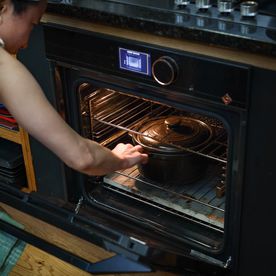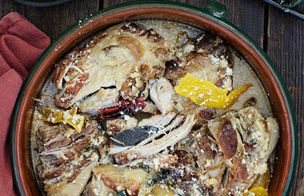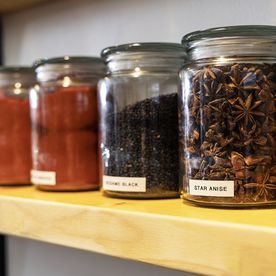Reset Your Kitchen for Winter: How Pros Prepare for the Cold Months
14th October 2025
The light changes. The air cools. And how we’re cooking shifts too: slower, steadier, with less heat and less haste. And your kitchen needs to change with the season.
This isn’t just about what you’re eating, its about how the kitchen flows. At Dublin Cookery School, we rework our kitchen every winter. Pantries are reset. Equipment rotates. Techniques shift from quick sears to long, patient cooking. The same logic applies at home. Adjusting how your kitchen works isn’t about style; it’s about cooking that makes sense for the season.

1. Cook Slower, Plan Smarter
Summer cooking can be quicker (or non-existent if its so hot you’re reaching for the salad bowl). You’re grilling on the BBQ, searing fish, and slicing fresh fruit. Summer is full of dishes that take minutes, not hours.
Winter flips that. The ingredients are denser and the sauces richer.
Winter dishes need time and steady heat. In the cookery school, we’re relying on the fantastic temperature control in our De Dietrich ovens.
Professional kitchens call this thermal balance: letting heat do the work while you get on with other things. Consistent temperature over long periods is what makes braises work. You're not chasing high heat; you're holding 150°C for a few hours while life goes on around you.
Pro Tip: Cook Once, Eat Twice (Or Thrice): The trick is to cook big. A stew, curry, or ragu cooked once can stretch into three different meals. Yesterday’s braise is tomorrow’s pasta sauce, or Thursday’s Taco Topping. When reheating, cool food fast before refrigerating, then warm gently so flavours build rather than flatten. It’s how restaurants keep depth across service — no shortcuts, just structure.

Slow-Cooked Pork Shoulder with Swiss Chard & Parmesan
Start “Slow-Cook Season” with a bang with our recipe for Slow-Cooked Pork Shoulder with Swiss Chard & Parmesan. It creates a meltingly tender meat that's perfect for a Sunday dinner, with rich leftovers for tomorrow.
Find out more2. Winter Kitchen Equipment: What to Store Away, What to Bring Forward
Look at your counter. If your salad spinner is still out, it's time to pack it away. Make room for what winter demands:
- A sturdy food processor for breaking down root vegetables quickly
- Heavier pots that move from hob to oven without fuss
- A reliable slow cooker—if you've been thinking of investing, winter justifies the cost (here’s one of our faves where you can steam your rice to go with your pork shoulder…) (LINK TO NINJA)
Your ingredients shift as well. Beetroot, celeriac, parsnips, and swede replace summer's tomatoes and courgettes. These vegetables store longer, cost less in season, and stand up to hours of cooking without falling apart.

Check your pantry now. Stock up on:
- Dried pulses (lentils, chickpeas, cannellini beans)
- Tinned tomatoes
- Robust vinegars (balsamic, sherry) for winter salads
- Fresh stock (Carol's Stock Market or Sadie's Kitchen)
Pro Tip: There is such a thing as quality in canned and jarred goods and some of these can be a great time saver. Good quality pulses eg. Epicure and Biona; fruit in their natural juice; fish eg. Shines Irish fish selection; or chopped tomatoes, you can’t beat Mutti Polpa - see if they stock them in your local supermarket.
And don’t forget to keep your spices close to hand. Place your go-to spices in an easy to reach spot, like an open shelf or spice box by your prep station.
3. Store Smart, Waste Less
Half the battle in winter is storage. You’re cooking more, and ingredients take up space.
Root veg don’t belong in the fridge — they like it cool, dry, and dark. If you can, keep them in a box or crate with a bit of airflow. The fridge is for the things that spoil quickly, not the ones that last months.
When you batch cook, spread food in shallow containers before freezing so it cools quickly and evenly. Stack them neatly and date everything. We do this at the school every day. It’s the only way to know what you’ve got and stop food from dying quietly at the back of the freezer.
Chef’s Rule of Thumb:
- If it grows underground, keep it cool and dry.
- If it grows above ground and wilts, keep it cold and slightly damp.
- If it comes in a bag, label it and rotate it.
Winter Veg Storage Cheat Sheet
| Ingredient | Best Storage | Temp(°C) | How to Keep It at Its Best |
|---|---|---|---|
| Potatoes | Dark, dry crate or basket with airflow | 7–13 | Keep away from onions. Never refrigerate — cold turns starch to sugar. |
| Carrots | a cool dark place or once cut in a bag in the fridge | 2–4 | Trim tops. Slight moisture keeps them crisp. Don’t wash until needed. |
| Parsnips | a cool dark place | 2–4 | Store in a paper bag to prevent limpness. |
| Celeriac | Cool, ventilated space & once cut bottom of fridge wrapped in paper | 5–10 | Keep skin on. Brush off dirt, don’t wash before storing. |
| Onions | Mesh bag, ventilated cool spot | 10–15 | Dry and separate. Avoid stacking with potatoes. |
| Garlic | dry spot or in a mesh bag | 10–15 | Whole bulbs keep best. Discard any that sprout or soften. |
| Cabbage | Fridge drawer, wrapped loosely in paper | 2–4 | Store whole; once cut, cover tightly and use within days. |
| Kale / Sprouts | wrapped in damp paper towel and placed in bag in fridge | 2–4 | Keep dry. Remove any yellow leaves before storing. |
| Butternut Squash | Cool, dry shelf (not stacked) | 10–15 | Whole squash keep for weeks. Once cut, wrap and refrigerate. |
| Apples | Cool box in pantry | 4–10 | Separate from veg — they release ethylene that speeds ripening. |
4. Clean Before the Rush
Before you settle into months of roasting and braising, give your kitchen a proper reset. Not a quick wipe-down—a real clear-out.
- The Pantry: Check dates. Toss anything past its prime. If you've got half-opened bags of flour or rice, transfer them into sealed containers. Reorganise so you can see what you actually have—this prevents buying duplicates and makes winter cooking smoother.
- The Fridge: Clear the back shelves. Check jar seals. Make space for what's coming: larger cuts of meat, the selection of cheese, larger quantities than usual of dairy products and eggs, and batch-cooked meals.
- The Oven: If it hasn't had a deep clean since last winter, do it now. A dirty oven doesn't heat evenly, and when you're relying on it for three-hour braises, that matters. Use a self-clean cycle if you have one, or get a good cleaner and give it the attention it deserves.
- The Hob: Food builds up around burners and under grates. A proper scrub now makes everything cook more evenly later.
This kind of maintenance isn't glamorous, but it's what professionals do—and it's one of the practical lessons woven into our longer courses, where we teach not just recipes but how to run a kitchen that works with you, not against you.
Winter Cooking FAQ
- What are the best cooking methods for winter meals?
- Slow, steady heat works best — braising, roasting, and simmering. These methods develop deeper flavour from tougher cuts and root vegetables.
- How should I store root vegetables and winter produce?
- Keep roots like potatoes, squash, and onions in a cool, dry spot. Store leafy greens and brassicas in the fridge in perforated bags.
- Should I deep-clean my oven before winter cooking?
- Yes. A clean oven holds steady heat and cooks evenly, which matters when you’re roasting or braising for hours.
- What kitchen equipment do I need for winter cooking?
- A heavy casserole pot, solid chopping board, sharp knives, and a reliable oven or slow cooker are essentials for long, gentle cooking.
- How can I save time when cooking in winter?
- Batch cook. Make large pots of soup, curry, or stew, then cool and freeze portions. Rotate what you use first to cut midweek prep.
- What vegetables are in season for winter cooking?
- Carrots, parsnips, beetroot, cabbage, kale, and squash are at their best. They store well and hold their shape through long cooking.
